SAUGATUCK

Collector Series Featuring Patrick Sikes Photography




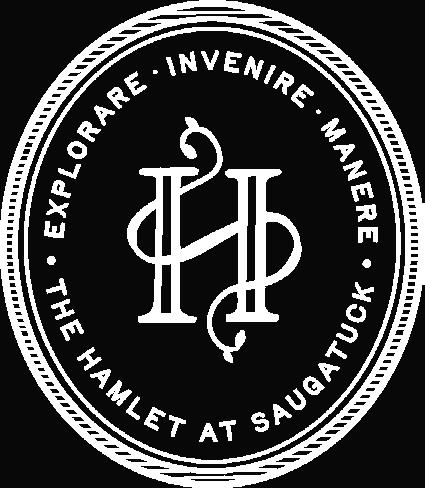





Collector Series Featuring Patrick Sikes Photography








The #1 question I’m asked is if this year’s housing market will be like 2024… and 2023…and 2022.
#1 question I’m asked is if year’s housing market will be 2024… and 2023…and 2022.
The #1 question I’m asked is if this year’s housing market will be like 2024… and 2023…and 2022.
Now, I’m not an expert in tasseography (tea leaf reading), but I do have tea to spill... Here’s what I expect to continue into 2025, and what changes you should watch out for.
I’m not an expert in tasseography (tea leaf reading), do have tea to spill... Here’s expect to continue into and what changes you should watch out for.
Now, I’m not an expert in tasseography (tea leaf reading), but I do have tea to spill... Here’s what I expect to continue into 2025, and what changes you should watch out for.
Ready to discuss your 2025 real estate plans? Get in touch!
to discuss your 2025 real plans? Get in touch!
Ready to discuss your 2025 real estate plans? Get in touch!

1.
1.
High demand, low supply: The median sales price of single family homes has risen 92% over the past five years due to the record low inventory levels in Westport.
High demand, low supply: The median sales price of single family homes has risen 92% over the past five years due to the record low inventory levels in Westport.
High demand, low supply: The median sales price of single family homes has risen 92% over the past five years due to the record low inventory levels in Westport.
2.
4. 5.
4. 5.
4.
Fence sitters are re-entering the market: Faced with higher interest rates compared to 2021, many buyers chose to wait for rates to drop. However, people are jumping back into the market, realizing there may be a cost to waiting
Fence sitters are re-entering the market: Faced with higher interest rates compared to 2021, many buyers chose to wait for rates to drop. However, people are jumping back into the market, realizing there may be a cost to waiting
Fence sitters are re-entering the market: Faced with higher interest rates compared to 2021, many buyers chose to wait for rates to drop. However, people are jumping back into the market, realizing there may be a cost to waiting
2.
Year-round sales: Westport real estate has become a year-round market. High demand means more sales will occur outside of the busy spring and fall, if listings are available.
Year-round sales: Westport real estate has become a year-round market. High demand means more sales will occur outside of the busy spring and fall, if listings are available.
Year-round sales: Westport real estate has become a year-round market. High demand means more sales will occur outside of the busy spring and fall, if listings are available.
2. 3.
5.
Even MORE love for Westport: Who knew that was possible? As hybrid work has gained more traction, interest in properties that offer the best of both worlds — suburban charm but with convenient access to the city for those in-office days — have increased.
Even MORE love for Westport: Who knew that was possible? As hybrid work has gained more traction, interest in properties that offer the best of both worlds — suburban charm but with convenient access to the city for those in-office days — have increased.
Even MORE love for Westport: Who knew that was possible? As hybrid work has gained more traction, interest in properties that offer the best of both worlds — suburban charm but with convenient access to the city for those in-office days — have increased.

3.
3.
Lauren
Lauren
Bonus
Bonus


I was raised in Fairfield County and returned to raise my family. I know and love everything about this area.
I was raised in Fairfield County and returned to raise my family. I know and love everything about this area.
I’m committed to staying ahead of the curve, blending cuttingedge technology and forwardthinking strategies. But above all, I am grateful to be a part of this chapter in your story.
I’m committed to staying ahead of the curve, blending cuttingedge technology and forwardthinking strategies. But above all, I am grateful to be a part of this chapter in your story.








16 Forever Modern Westport-based Heller furniture has a long history of breaking boundaries; here’s what is next for the innovative brand.
24 Partners by Design
Edie van Breems and Rhonda Eleish reflect on their years of friendship, thriving business and the timeless nature of Scandinavian design.
6 EDITOR’S LETTER 8 NEIGHBORHOOD NEWS Play for Good
LOCAL PROVISIONS Heart & Home
THE REFIT Brush up on Color
MIND & BODY Full-Body Fitness 32 REFLECTIONS Life in the Speakeasy Era
Saugatuck magazine is thrilled to partner with local photographer Patrick Sikes to bring you fine art covers in 2025. Learn more about Patrick’s work at patricksikes.com.
Photograph by Patrick Sikes

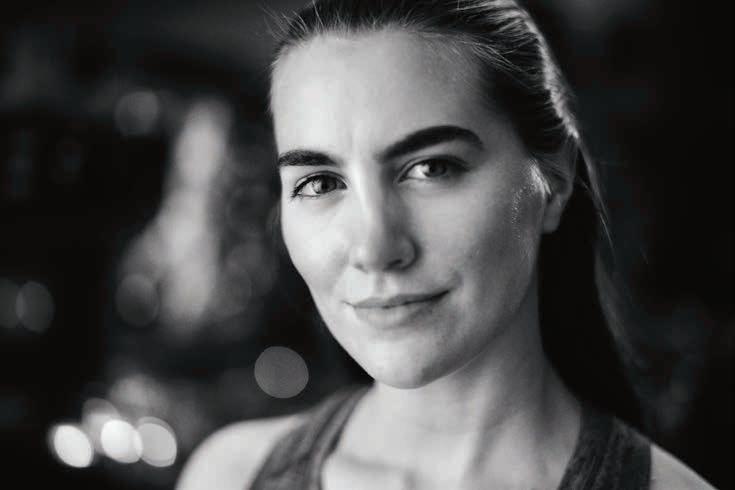
IN THIS ISSUE, we explore a topic that Saugatuck knows well—this district is a hub for furniture, interiors and building design. As pillars of the community, Edie van Breems and Rhonda Eleish of Eleish Van Breems walk us through nearly three decades of bringing Scandinavian and Gustavian tastes to Westport. Also, read what John Edelman of Heller Furniture said to

us about his company’s history and what defines “modern” design. However, Saugatuck goes beyond just aesthetics; it’s a place of incredible warmth and a sense of belonging. From neighbors coming together for children’s charities, to Chef Michelle Greenfield’s refined yet welcoming Allium Eatery, this neighborhood has a unique glue that holds us all together.
Since the publication of our March issue, I have received some very kind words from several Saugatuck neighbors. I can’t thank you all enough for the warm welcome this publication has received from the community. I hope you continue to enjoy Saugatuck magazine.

Colleen Crowley Editor
Publisher Ryan Pearson
Editor Colleen Crowley
Creative Director Kijoo Kim
Interns Fall 2024
Jenna DeBiase
Haiden Leach
Valentina Ortiz Elian
Interns Spring 2025
Ayasha Cantey
Lizzy Carpenter
Gabriella Vilas Boas
Contributing Photographer
Patrick Sikes
WAINSCOT MEDIA
Chairman Carroll V. Dowden
President and CEO
Mark Dowden
VP, Group Publisher, Regional Thomas Flannery
VP, Content Strategy
Maria Regan
Associate Editor Sophia Carlisle
Art Director
Rosemary O´Connell
Advertising Services Director
Jacquelynn Fischer
Operations Director Catherine Rosario
Production Designer
Chris Ferrante
Print Production Manager Fern Meshulam
Advertising Production Associate Griff Dowden
Saugatuck magazine is published by Wainscot Media. Serving residents of Saugatuck and the shoreline communities of Westport, Connecticut, the magazine is distributed monthly via U.S. mail. Articles and advertisements contained herein do not necessarily reflect the opinions of the publishers. Copyright 2025 by Wainscot Media LLC. No portion of this magazine may be reproduced in any form without written consent.








1. No More Stolen Packages: Your packages are safe until you pick them up.
2. Convenience: We text/email you when your package arrives! Come pick it up when you can.
3. Mail Forwarding: If traveling, get your mail forwarded wherever you are.
4. Professional Appearance: Every private mailbox has its own street address, adding professionalism to your business.
5. Privacy: Seperate business from personal; keep your home address unpublished.
6. Reliability: Someone will always be there to receive important shipments.
7. Full Service Package Recieving: We’ll accept pakages from every mail carrier.








How
the Day of Champions brings together a town and
uses friendly competition to help grieving children.
By Lizzy Carpenter with Colleen Crowley
THIS SPRING, when you drive past Saugatuck Elementary School, you may hear the sound of feet hitting the turf, loud cheers and playful banter. It might seem like just child’s play, but on May 18, something much more special will be happening. That Sunday, the sixth annual Day of Champions will take place on the PJ Romano Field, raising money and awareness for Experience Camps.
Founded in 2009, Experience Camps provide an outlet for children experiencing grief from the loss of a parent, sibling or primary caregiver. With no-cost, one-week summer sleepaway camps and year-round events, Experience Camps allow children to be open about their grief journey and help instill the tools to work through their emotions.
Day of Champions is a fundraiser to aid in the cost of camp, and the emphasis is truly on having fun. Each year, 20 teams gather for an all-out, field day-like competition. With activities such as tugof-rope, relay races and dance parties, Day of Champions brings the entire Westport community together to put on their game faces, forget their troubles and raise some money for the kids.
This strong community aspect is what makes Experience Camps unique and why so many families and individuals gravitate toward their mission, including Lexie Radwan and Julia Budnick-Szeftel. The two Westport-based women proudly co-chair the Day of Champions.
Budnick-Szeftel lost her father at a young age, and as an adult, she volunteered as a bunk counselor at several Experience Camp locations. When she took a hiatus and moved to Westport to start her family, Budnick-Szeftel connected with fellow Westporter Sarah Deren, the CEO of Experience Camps. Budnick-Szeftel wanted to get involved and put down some roots, and she was soon paired with Radwan and tasked with running the Day of Champions event.
Similarly, Radwan had been looking for a way to connect after settling in Westport and starting her family. After six years of working for Experience Camps, she knew firsthand the importance of this fundraiser, and she jumped at the opportunity to cochair with Budnick-Szeftel.
Although most participants in the Day of Champions are not Experience Campers, the day is centered on inclusivity and the involvement of neighbors and friends of all ages. For younger participants, it’s especially important because “it’s the first introduction to loss for kids who may have not experienced it,” says Budnick-Szeftel. “It teaches them how to treat someone who’s lost someone.”
The day is far from sad. “Our concept of joy and grief is that they go hand in hand,” says Radwan. “You can’t have one without the other, and it all starts with play.”
The day is family-focused, open to ages 5 and up. Parents and their kids don matching face paint and costumes, and


Day of Champions activities raise funds that help grieving children attend Experience Camps to work through loss.
many families and teams return year after year— a testament to how strongly locals support the organization and its mission.
“Experience Camps remind children that though grief may feel all-consuming, so is love, and that they are not alone and that there will always be a community to help guide them,” says Radwan. “Kids attend camp at no cost, and that is all thanks to the generosity of the Westport community during Day of Champions.”
This year, fundraisers like Day of Champions will help send 1,600 children to Experience Camps across the country. And 2025 marks a special year for the organization: It is celebrating the opening of its Connecticut camp location.
Team registration for the Day of Champions event is still open, and non-participating spectators are always welcome to cheer on teams. For more information on Experience Camps or to learn more about how donations can be made, visit experiencecamps.org.
Lizzy Carpenter is a senior at Quinnipiac University studying media studies and public relations. When she isn’t studying, she enjoys writing, acting or finding the best lunch spots in Fairfield County.




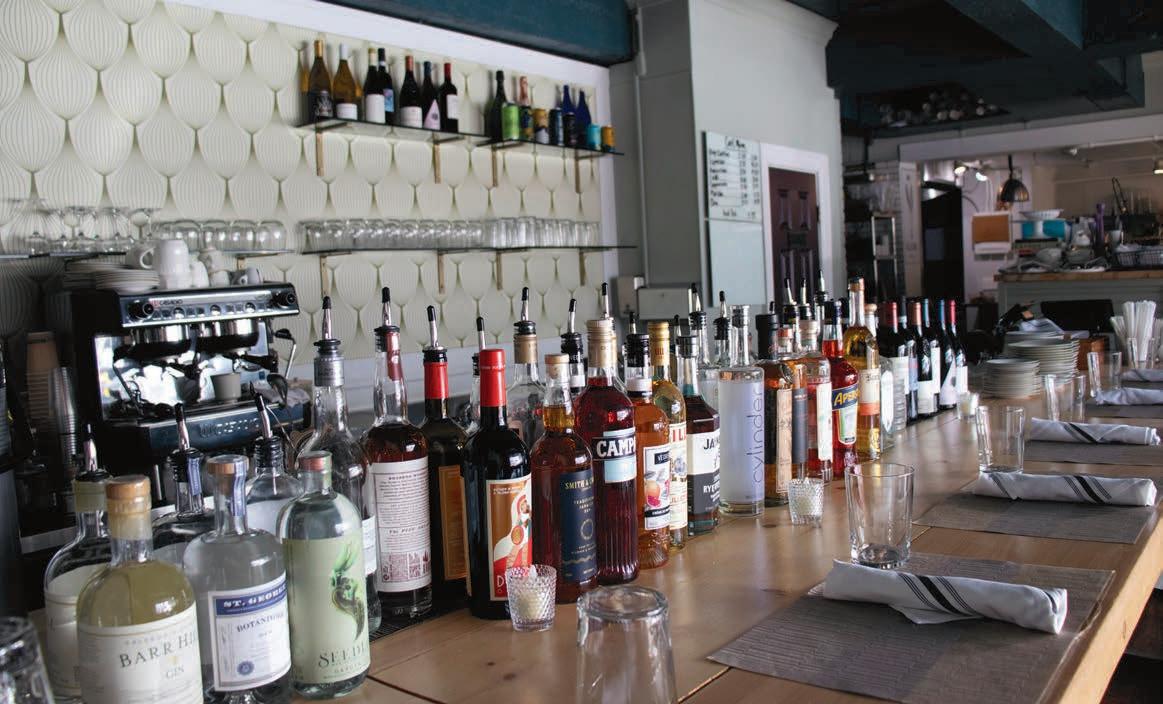
Flavors and feelings come together at the celebrated Allium Eatery.
By Gabriella Vilas Boas and Colleen Crowley
FOOD AND FLAVORS have made Saugatuck a dining destination, and the buzz surrounding Allium Eatery’s Chef Michelle Greenfield has focused an even bigger spotlight on the area.
The seasoned chef began her journey at a young age. “I never had to think about what I wanted to do in life; it was always instinctively cooking,” says Greenfield. Thankfully her parents encouraged her passion, and she went on to the Culinary Institute of America for her training in culinary arts.
After a stint working the line in an Italian restaurant in Providence, Rhode Island, Greenfield joined the kitchen at Bernard’s Restaurant in Ridgefield, refining her classic French technique under Chef Bernard Bouissou. She then moved to The Schoolhouse at Cannondale, where she explored new flavor profiles and
started developing a following.
When the COVID-19 pandemic hit and restaurants closed, Greenfield was invited to teach at her former high school’s culinary program, where she met Norah Harrington.
“I could quickly see that she had heart, dedication, a natural talent and skill set and she’s an incredibly hard worker,” says Greenfield. Harrington was serious about her work in the kitchen and decided to follow Greenfield as her sous chef when Greenfield took a leap of faith and opened Allium Eatery in the fall of 2021, at 54 Railroad Place.
“I committed and dove facefirst,” says Greenfield. As the sole owner, Greenfield poured everything she had into the charming eatery. “For me, this is my home, this is my heart.”
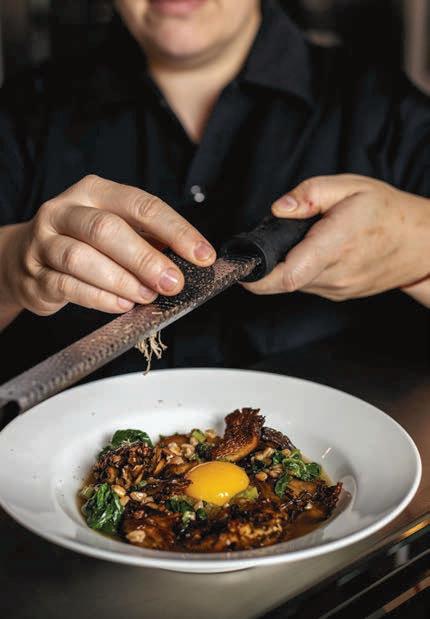

Greenfield wanted Allium to feel like a home for patrons, too. The cozy restaurant seats 14 people and offers patio seating in warmer months. Guests feel more like friends, popping in for a coffee and a chat or grabbing a rotisserie chicken to go. Some even have standing weekly reservations at “their table.”
“It really has blossomed into a great little neighborhood place; we know most people by name,” says Greenfield. “It’s super important that I’m involved with the dining room just as much as I am in the kitchen.”
With usually just Harrington and herself working during service, Greenfield juggles cooking, answering the phone, waiting tables and more— all part of the incredibly hands-on experience she hopes to provide.
And it’s not just the atmosphere that sets Allium Eatery apart—the food is an experience as well.
Allium’s kitchen strives for excellence, using in-season, locally sourced ingredients as often as possible, with a menu crafted to reflect the ingredients’ natural cycle of growth. “Why serve something that’s not at its best?” quips Greenfield.
Foundational dishes of chicken, fish, duck and beef allow Greenfield to play with complementary flavors, often drawing inspiration from the energy (and weather) of the day. She particularly relishes combining textures, temperatures, and tasting notes to keep the menu exciting, guiding her guests to explore and expand their palates.
Through it all, Greenfield and her Allium team never expected their home-away-from-home to skyrocket the way it has. What originated as a love letter to the culinary arts has drawn maxed-out reservations and double the volume Allium is used to, thanks to this year’s nomination for Best Chef: Northeast from the James Beard Awards.
By cultivating lasting experiences and connections between her food and the Saugatuck community, Chef Greenfield proves that success can be born organically.
“It still doesn’t feel real—I just wanted to do what I love, and now people know who I am,” exclaims Greenfield. “It’s not what I was expecting, but it’s a journey, and we’re along for the ride.”
Gabriella Vilas Boas is a journalism student at Quinnipiac University. She can be found on social media @gabriellavbpress.
Greenhaus founder Jessica Araujo offers tips on choosing between bold paint trends and crowd-pleasing classics.
By Ayasha Cantey


JESSICA ARAUJO founded Greenhaus in 2020, right in the midst of a chaotic time when people were stuck at home, realizing their walls needed a change. The company was born out of her deep-rooted passion for painting, influenced by a childhood spent learning different trades from family members.
After noticing a lack of organization and standardization in the industry, along with the underrepresentation of women, Araujo was determined to fill the gaps, operating with structured processes while opening doors for more women in the field.
As spring arrives and color re-enters

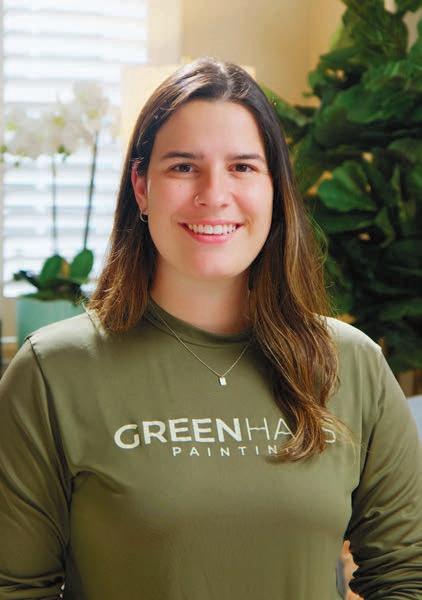

our lives, the urge to give your walls a fresh coat might hit. We spoke with Araujo and asked her advice for homeowners looking to incorporate both timeless shades and fresh “of-thenow” color in their spaces.
What current paint colors are dominating the market right now?
Current paint color trends favor warm, cozy neutrals over stark whites and cool grays. Accessible beige is replacing Agreeable gray, and color drenching— painting walls, trim and ceilings the same color—is very popular. Moody tones like deep greens, charcoal blues, earthy browns, purples and terracottas are trending. Additionally, wallpaper is making a big comeback.
Have any once-trendy colors evolved into classic choices?
Absolutely! Navy blue or Hale Navy used to be trendy, but now it’s a staple. It’s the same with warm greiges like Revere Pewter—it started as a trend but became a go-to neutral.
Are there certain rooms where trendy colors work better than timeless ones?
Trendy colors work best in powder rooms, offices and accent walls for lowcommitment experimentation. Timeless colors are ideal for main living areas and exteriors, where longevity is key.
What is the easiest way to incorporate color without painting the whole room?
The easiest way to incorporate color without painting the whole room is through accent walls, ceilings, contrast trim, furniture and decor. A bold dresser, artwork or painted doors and bookshelves can add color without commitment.
Does the type of paint finish (matte, satin, gloss) impact whether a color feels trendy or timeless?
Flat and matte finishes feel modern and on-trend. Satin and eggshell finishes are classic and work for most spaces but tend to show more imperfections in older homes. High gloss often looks bold and dramatic, which can lean trendy but also timeless in the right application, like a front door.
How does natural lighting affect the way color appears in a space?
Natural lighting significantly impacts how a color appears— shades like sage green may shift to outdated tones under artificial light. Always test swatches in various lighting conditions before committing.
How do you define the difference between a timeless paint color and a trendy one?
Timeless colors are like classic jeans—neutral, versatile and always in style, including soft whites, muted grays, taupes and deep greens, blues and yellows. Trendy colors, on the other hand, are bold and ever-changing, like a statement jacket that was in style last year. Currently, moody tones such as plum purples, vibrant browns and deep reds are making a comeback.
What factors should homeowners consider when deciding between timeless and trendy colors?
1. How often do I want to repaint? Trendy colors can date your space faster.
2. What’s the purpose of the room? Bold colors can energize or bring comfort to a space, while neutrals keep things calm.
3. Resale value? If you’re selling soon, stick to timeless tones. If not, have fun with color and make it yours!
What are some classic paint colors that have stood the test of time?
• Swiss Coffee (Benjamin Moore): a warm, cozy white
• Revere Pewter (Benjamin Moore): the perfect greige
• Hale Navy (Benjamin Moore): a deep, rich navy
• Essex Green (Benjamin Moore): a sophisticated, dark green
• Dove White (Benjamin Moore): a clean, soft white
Are there certain colors that people naturally feel more comfortable living with long-term?
Definitely! Soft whites, muted grays and earthy greens/blues tend to feel calming and livable.
How do color trends reflect broader design and fashion trends?
When fashion embraces warm, earthy tones, interiors follow suit. When minimalism and clean lines are in, paint colors shift to cool neutrals. When monochrome and earth-tone trend in fashion, it can also influence home design.
A senior English major minoring in writing, gender studies and health humanities, Ayasha Cantey has always had a passion for writing and hopes to craft pieces that bring encouragement and inspiration.



by Colleen Crowley
DECEMBER 30, 2009. Splashed
across The New York Times is an image of Alan Heller holding his Bellini chair, accompanied by a story in which Heller publicly calls out Design Within Reach (DWR) for copying his design and details his lawsuit against the company.
John Edelman was poised to assume his role as CEO of DWR within the week, and his first course of action was getting in touch with Heller. After a conversation, Heller and Edelman became fast friends, all the knockoffs were pulled off the market and DWR became Heller’s biggest customer.
Thus began a lasting friendship that would change the trajectory of their lives, both personally and professionally.
But the story of Heller furniture goes back much further, to 1971. Heller had been inspired a few years earlier when he saw stackable melamine dishes designed


by Massimo Vignelli and approached the designer. The original Italian manufacturer of the pieces had gone out of business, and Heller (himself the son of a housewares manufacturer) saw the potential for collaboration. With a few design tweaks to better suit the American consumer—larger cups to accommodate coffee instead of espresso shots—the now iconic Heller dinnerware was born.
Success followed, with more household items added to the company’s repertoire, like Lella and Massimo Vignelli’s benches
and Sergio Asti’s ice bucket. Designers began approaching the company with ideas, including Philippe Starck’s cheeky 1994 Excalibur toilet brush. The nature of the molded plastic products meant they were priced accessibly, allowing many people to own and collect Heller designs.
The furniture division of Heller launched in 1998 and the aforementioned Bellini chair, designed by Mario Bellini, went public in 1999. It was featured in DWR’s first catalogue and sold thousands of units through the retailer over the years. In 2001, the chair won the Compasso d’Oro, the Italian design-equivalent of

the Oscar. A collaboration with lauded architect and designer Frank Gehry further solidified Heller’s place in the modern design space.
The relationship between Heller and DWR continued through the 2000s, bringing Heller products to more customers than ever (although, according to Edelman, the smaller design company sometimes struggled to keep up with the larger retailer’s demand and didn’t fully capitalize on their potential). That relationship soured in 2009 when DWR began producing a shockingly similar-looking chair to Heller’s Bellini, for about $50 less. That’s when Edelman entered the picture.
Edelman himself has been connected to the design world for most of his life. His parents owned a Newtown-based fine leather business, and after seven years working at his brother’s shoe company, Edelman joined his parents’ business and started making connections in the design trade. During this time, Edelman visited the 26th Street Flea Market in New York City every weekend. “I became impassioned about modern furniture,” says Edelman.
When he approached Herman Miller about supplying their leather, Edelman’s product was graded into the famed furniture company’s catalog as an upgrade. Edelman Leather took off and is now a lifestyle leather company, encompassing residential, hospitality, corporate interiors and private aircraft products.
In 2009, a business acquaintance tapped Edelman for his expertise in running and operating a company, which led to his assuming the role of CEO of DWR. What followed was a decade of repairing relationships with designers, restructuring, product launches and astounding growth. When Edelman sold DWR to Herman Miller in 2019, the brand was five times as large as when he started.
After an intense few years in the corporate world, Edelman took some time off and experimented in the
beverage industry, but his love of modern furniture and his friendship with Heller kept him close to the design industry.
Edelman had tried to buy the company multiple times over the years, but Heller himself was a bit of a tease, joking that he’d be buried with the molds of the company designs. Upon Heller’s passing in 2021, Edelman finally purchased the company.
“That’s the only company I wanted to buy,” says Edelman. Barbara Bluestone, Heller’s companion for the last 20 years of his life, told Edelman he was the
only person she was allowed to sell the company to, per Heller’s wishes.
“My passion is modern furniture, so I just knew Heller was my fantasy business,” says Edelman. “I want to work with the design community, work with designers to create the next generation of modern design.”
The purchase of Heller Furniture included little else besides a brand, a collection of products and a single employee. There was no infrastructure, marketing team, sales force or customer service. The company hadn’t launched a



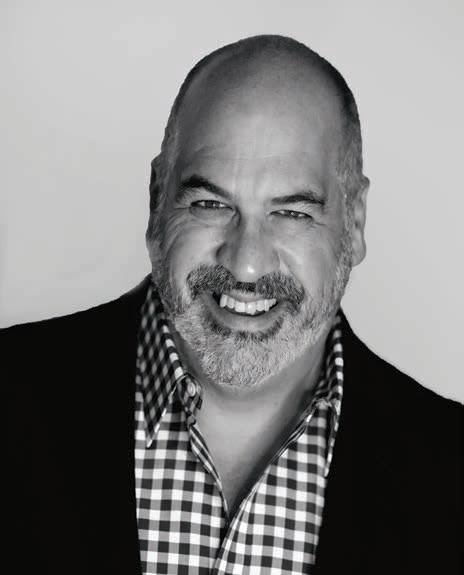
and Alan Heller (bottom right and at right with architect Frank Gehry) have consistently filled a need for affordable household designs.
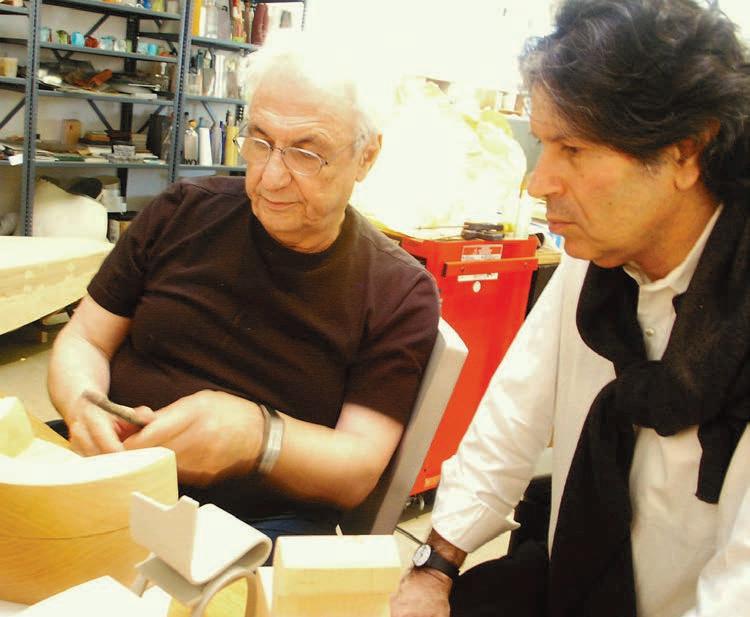
new product in 25 years, and Heller’s poor health before his death meant many accounts and business affairs had fallen into disarray.
Edelman and his new business partner Andrew McPhee (son of Edelman’s longtime collaborator and friend John McPhee) immediately got to work, and the company has been in overdrive ever since.
Classics like the Vignelli Rocker and Hellerware were revived in the first year of business, in addition to a Bellini stool that complemented the chair that started Edelman’s Heller journey. New products, like Anna Dawson’s Swell Wall Catchall, Hylnur Atlason’s Bluff Chair and Limbo Chair (Edelman’s favorite piece), launched in spring 2023, to great acclaim.
By fostering both young and established designers, Edelman honors Heller’s legacy of mentorship, collaboration and telling the story of designers he believed in, in addition to bringing fresh ideas to market.
The push forward shows no signs of slowing down, and the latest development at Heller is perhaps the most groundbreaking:

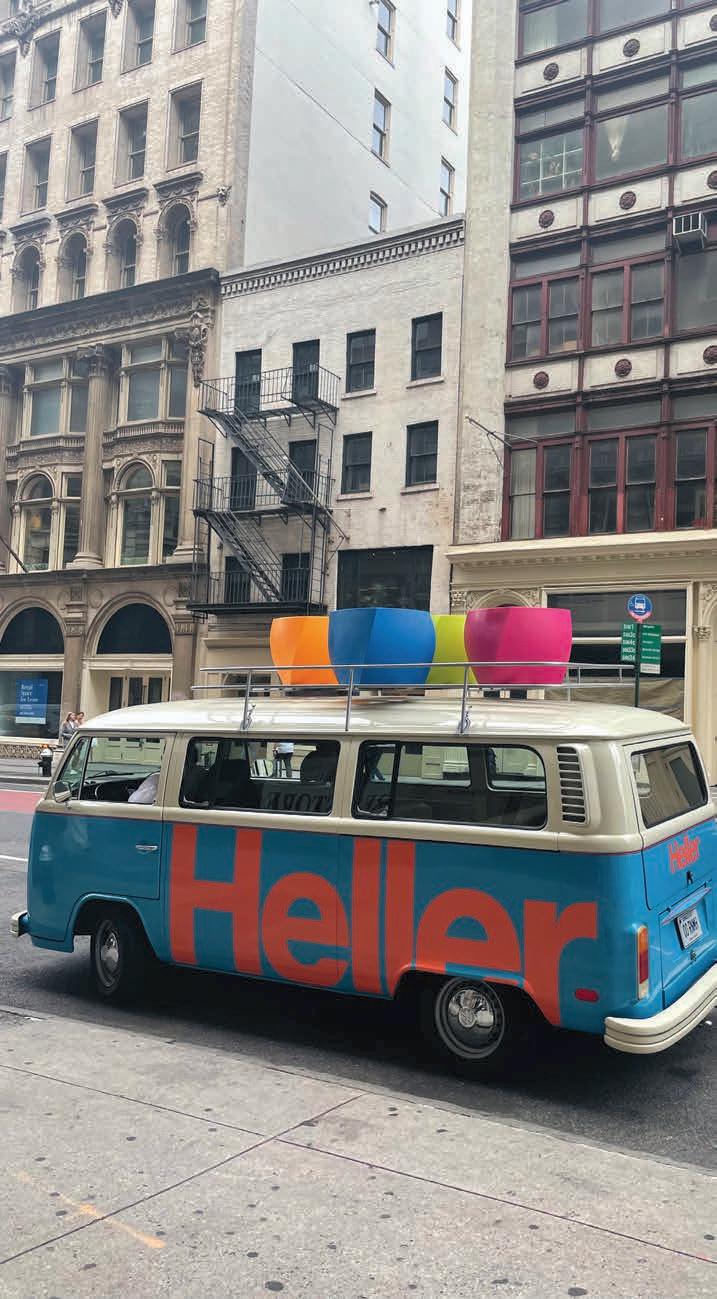

Starting this April, many plastic Heller products will be fully biodegradable. In collaboration with Worry Free Plastic, an organic enzyme will be embedded into Heller’s polymer material, and when left in an oxygen-free environment for three to five years, the enzymes are activated and consume the polymer, leaving behind nutrient-rich soil. All Heller furniture is already 100% recyclable through their closed-loop program, but Edelman thinks this new technology would have brought joy to the company’s founder.
“He was always obsessed with innovation,” says Edelman, “so I think this current partnership with Worry Free Plastics and making it biodegradable is something he would have dreamed of.”
The introduction of this cuttingedge technology serves Edelman’s ethos of doing good by being good to the environment and creating items that are built to bring joy and comfort every day.
Through it all, Edelman has upheld his four core beliefs of what makes “modern” design: “Modern is aesthetically pleasing, designed for a purpose, void of ego and it can go anywhere, penthouse to warehouse, and in this company, indoors and out,” says Edelman. “Modern is forever.”



Edie
van Breems and Rhonda Eleish reflect on a lifetime of friendship and shared creativity.
by Colleen Crowley
EDIE VAN BREEMS and Rhonda
Eleish are life partners in friendship and in business. The two women met as schoolgirls growing up in Westport and Fairfield respectively and became inseparable.
Creativity flowed easily in their families; van Breem’s mother was a Balanchine dancer and owned a ballet company, and her economist father aspired to be a fine artist. Eleish’s father was a diplomat
and an artist, and so the two men became close friends.
The girls spent their formative years together but went their separate ways to college. However, they quickly reunited after graduating while working in the photography and fashion industries in New York City. It was there that they realized their shared love of art and design was more than a passing fancy.
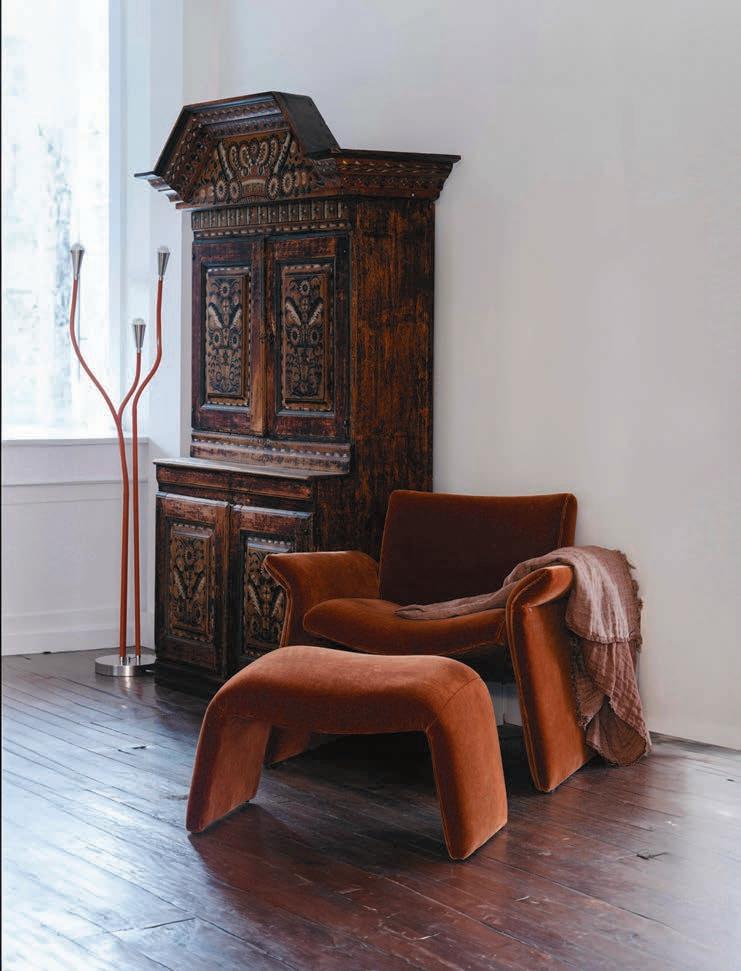
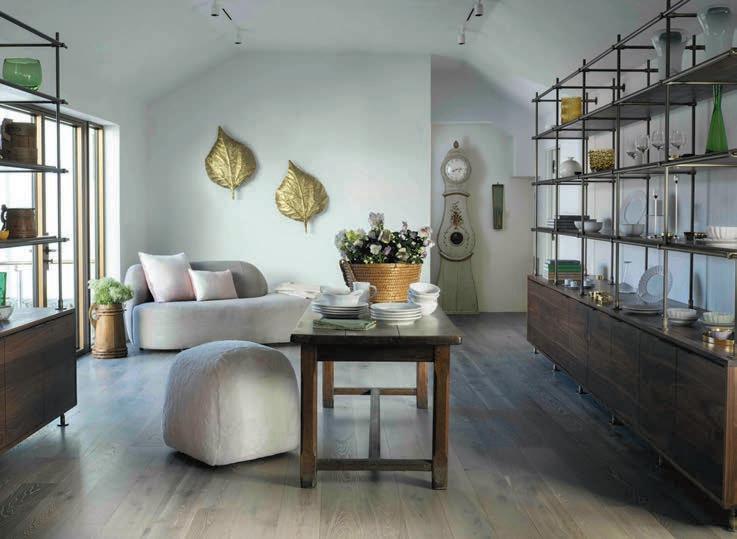
In 1997, they decided to open their first antiques import and design venture in Woodbury, Connecticut. Their European travels and shared Swedish roots naturally led them to sourcing and importing Gustavian antiques, often found in the barns and farmhouses of the rural Scandinavian countryside.
“Everything’s in balance in Scandinavian design,” says van Breems. “I think that’s something that we both really responded to after spending a lot of time there.” Combined with midcentury modern pieces and whimsical housewares, the Eleish Van Breems brand soon developed a distinct identity.
The business grew, and the pair were making trips to Scandinavia four times a year, each time filling a 40-foot shipping container with furniture pieces. After several years of this, Eleish took a step back, but she returned in 2015 after leaving her corporate job behind. The pair fully committed and soon opened their Saugatuck retail storefront at 22 Railroad Place. They quickly expanded to the next-door storefront, and then the office and studio on Franklin Street, each space with a slightly different personality.
After ten years in business, Eleish and van Breems have granted themselves permission to make their own design rules. After all, they have written three seminal books on the topic.
“We don’t really have one style,” notes van Breems. “We really are about the client and the project.” Across many of their interior design spaces, you’ll see the mixing and matching of midcentury modern with pieces that many people mistake for French classical. However, the simplified lines, muted color palettes and distinctive patina derived


from chalky mineral-based paint are markedly Gustavian, named after the Swedish monarchs of the late 18th century.
This more traditional foundation allows van Breems and Eleish to play elsewhere in the space with color and form; punchy, large-scale posters are a fixture in their showrooms, and they’re currently obsessed with Italian blown glassware.
While the items in their stores change with what they find interesting at the moment, in their interior design work, they do adhere to general Scandinavian design guidelines.
“In the Scandinavian design tradition, one takes into consideration
the natural light, the surrounding environment, nearby geographical elements and the building materials,” says Eleish. “All those environmental factors affect your interiors, so it’s a very holistic approach to how you design a house.”
Eleish and van Breems had a blueprint that worked for them and their clients, but they were faced with challenges with the arrival of online vintage and antique furniture sellers. The women had to reevaluate their business, both from a buying and selling standpoint. As pioneers in bringing Swedish design back to the United States,
seeing others co-opt their unique brand was disheartening.
Thankfully, they were always a multichannel business and had a loyal following, which allowed them to stay true to themselves and their vision.
“We are honored to have had such wonderful, long-term relationships with our clients,” says van Breems. That being said, the pair diversified their business and now have trade partners, robust online retail and custom upholstery and furniture options, in addition to their design services. Their line EVB Home encompasses everything you could need, from linens and décor to tote bags and toiletries.
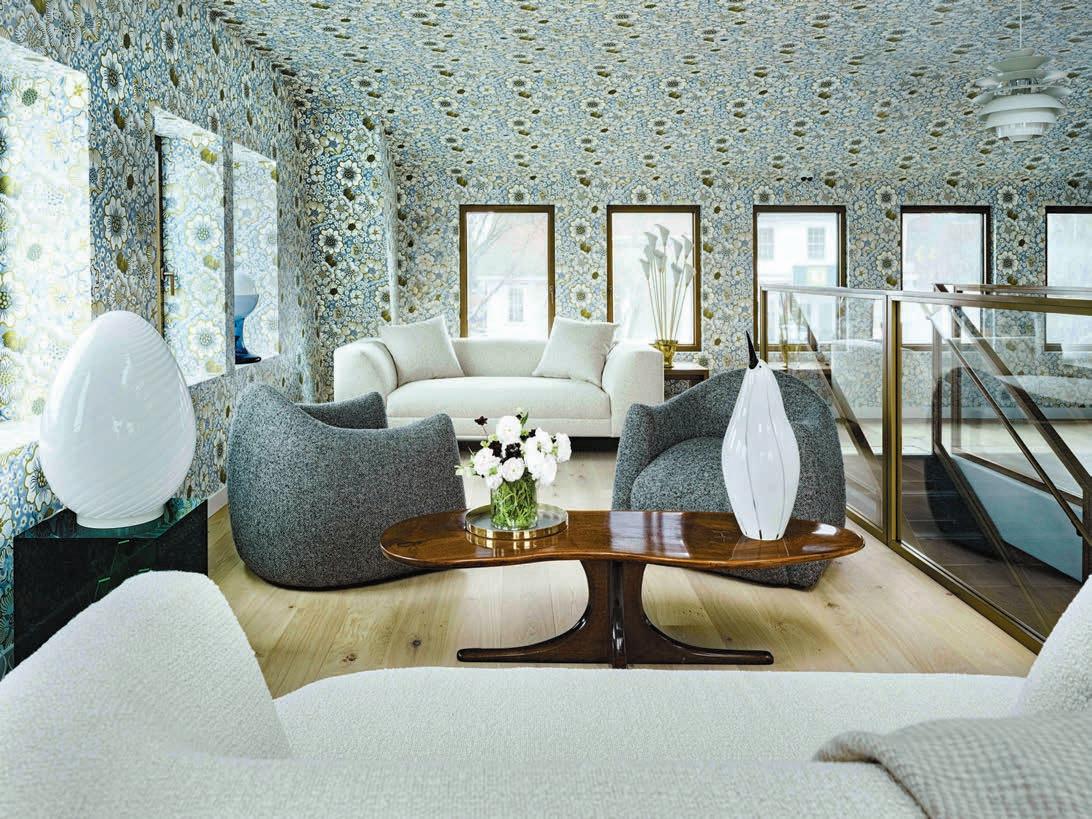
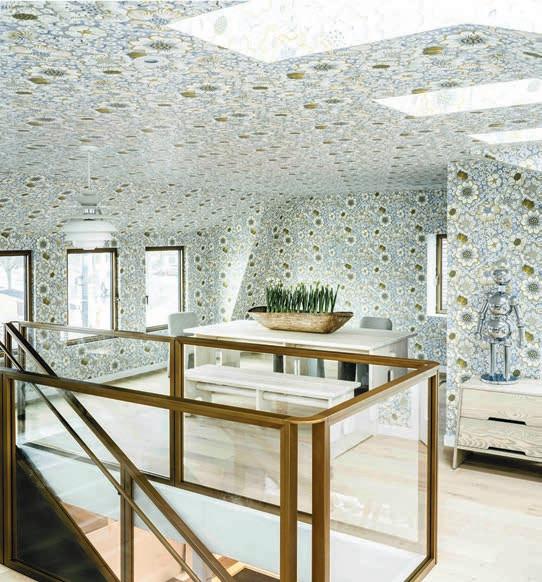


And business is doing well—so well that just a few weeks ago, their new flagship store and third retail location opened on Main Street here in Westport. The historic 1775 building, known to many Westport residents as the Remarkable Book Shop, holds fond memories from Eleish and van Breems’ shared childhood. Their parents often dropped them off there, at the top of Main Street, and allowed them to spend the day exploring
downtown on their own.
They always knew the space was incredible, and after seeing multiple businesses occupy and then leave the storefront in the last few years, the two decided the time was right to make the space their own.
The extensively restored space features ample natural light, exposed wood beams, and a dramatic and sleek staircase, leading up to a wallpaperbedecked second floor. And, of course, furniture, décor items, framed posters and examples of Gustavian antiques.
With this new retail space, the women reflect on how they want to approach the future in business, together. “I hope that we’re always able to be authentic, and that we’re always fresh and interesting and six months ahead of everybody else,” says Eleish.
After nearly three decades of design, van Breems faces the future with one goal in mind: “I want to keep inspiring people around us to have fun in their space and make their homes a sanctuary.”
“In the Scandinavian design tradition, one takes into consideration the natural light, the surrounding environment, nearby geographical elements and the building materials.”
- Rhonda Eleish



By Gabriella Vilas Boas
SARA FIELDS, owner of Sculpt by Sara, has always been a fitness enthusiast. She began her journey by teaching spin classes, but was left unsatisfied. “Then I started doing less cardio and more Pilates, and it just changed my whole body,” says Fields.
Fields earned her first of several Pilates certifications in 2015 and taught classes and private sessions at Equinox for six years. When the COVID-19 pandemic hit, she transitioned to teaching Pilates online, and Sculpt by Sara was born.
Once it was safe to gather in smaller spaces, Fields conducted in-person sessions with clients in a boutique studio. As the business quickly expanded, she realized she needed a space large enough to accommodate growing demand. Her new studio, tucked away on Franklin Street in Saugatuck, opened in the fall of 2024.
At Sculpt by Sara, Fields incorporates both new and traditional Pilates routines into her workouts. First developed in the early 1920s by Joseph Pilates, a German physical trainer, the system has since
grown with the evolution of exercise science and influences from physical therapy.
Most workout regimens consist of both mat and reformer exercises. Mat exercises are done on a yoga mat and utilize one’s own weight (and occasionally light weights) to target muscles. Reformer Pilates is done on a reformer machine, which guides one’s movements and offers resistance, and clients can add or remove weight for a lighter or heavier workout.
Because it focuses on smaller muscles and controlled movements, Pilates is often thought of as a mind-body exercise. The emphasis on muscle control, core stability, mobility and flexibility is attractive to those who want to build strength and improve movement.
“It really gets into your deep core, and that will help your lower back and your hips,” says Fields. “And it alleviates a lot of pain throughout the rest of your body.”
At Sculpt by Sara, clients do full-body workouts targeting abs, arms and legs.
Pilates can be individualized to meet one’s personal goals and limits, and the exercises are low-impact and can accommodate people of all ages. “I’ve seen everyone do it, from 10 to 100 years old,” says Fields. “One of my former clients was 83, and I have a 73-year-old client right now.”
Fields claims that Pilates is great for older clients, as it promotes focus and coordination, which is believed to help combat symptoms of Alzheimer’s disease and dementia.
Sculpt by Sara offers private and group workout sessions, where clients can receive hands-on adjustments. You can also start your Pilates journey from home by booking a virtual class or tuning in to a video online. For more information, visit www.sculptbysara.com.
Gabriella Vilas Boas is a journalism student at Quinnipiac University. She can be found on social media @gabriellavbpress.



STRENGTHEN, LENGTHEN AND FUN PILATES CLASSES
STRENGTHEN, LENGTHEN AND TONE YOUR BODY WITH CREATIVE AND FUN PILATES CLASSES

REFORMER, MAT, JUMPBOARD, PRIVATES AND DUETS
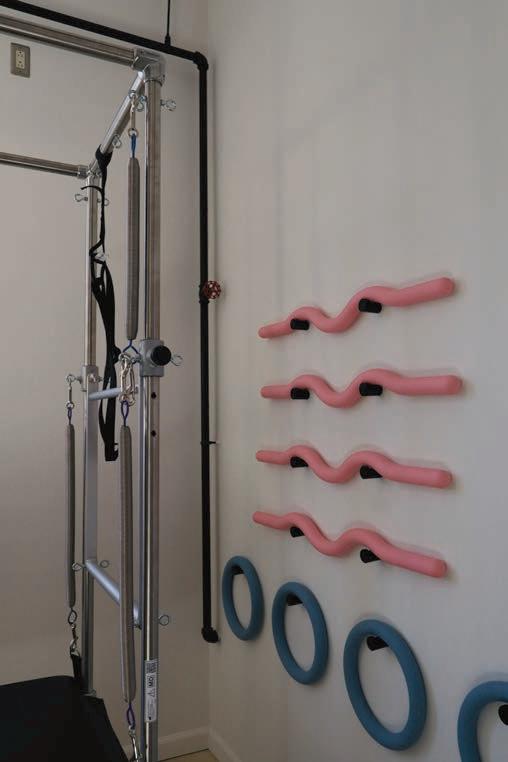



“SCULPT BY SARA IS THE BEST WORKOUT I’VE FOUND IN WESTPORT! EVERY SESSION IS DYNAMIC AND DIFFERENT FROM THE LAST, AND I WALK OUT FEELING BETTER AND STRONGER EVERY SINGLE TIME. MY FLEXIBILITY, STRENGTH AND POSTURE HAVE DRAMATICALLY IMPROVED OVER THE
“SCULPT BY SARA IS THE BEST WORKOUT I’VE FOUND IN WESTPORT! EVERY SESSION IS DYNAMIC AND DIFFERENT FROM THE LAST, AND I WALK OUT FEELING BETTER AND STRONGER EVERY SINGLE TIME. MY FLEXIBILITY, STRENGTH AND POSTURE HAVE DRAMATICALLY IMPROVED OVER THE COURSE OF JUST A FEW MONTHS!”
38 FRANKLIN STREET, WESTPORT CT PULL TO THE BACK OF THE BUILDING
38 FRANKLIN STREET, WESTPORT CT PULL TO THE BACK OF THE BUILDING Book your classes at sculptbysara.com
SCAN HERE:
SCAN HERE:



A recipe from the Westport Museum for History and Culture evokes the local bootleg scene during Prohibition.
By Westport Museum Staff
THE YEAR IS 1920. The sale of liquor has been prohibited nationwide. In Westport, Prohibition is widely flouted, with local police turning a blind eye. There are robust sales of illegal alcohol at speakeasies and in local hotels and restaurants. Oystermen on Long Island Sound and fishermen on the Saugatuck River make more money moving bootleg booze than plying their trades.
Building owners on the river are in a lucrative position to take advantage of this underground business. The Reindeer Inn, a well-known Westport roadhouse, in “Four Corners” near today’s Luciano Park, was known as a blind pig or speakeasy. Italian-American family businesses like Renzulli’s store,
Esposito’s Garage & Taxi and Arcudi’s Italian Market (earning Saugatuck the name “Little Italy”) surrounded the inn and provided unwitting cover.
The inn’s proprietor and bartender, George Ross, and his wife were arrested multiple times after raids. In 1923, the police raided the place and arrested two Norwalk youths—Frank Jones, a.k.a. Broadway Jones, and Omar Williamson, a.k.a. Young Mulligan—for attempted highway robbery in Westport.
As in other speakeasies, the colorful characters at The Reindeer Inn enjoyed popular drinks like the Bee’s Knees, featuring honey and lemon in a sweetsour combination that masked the harsh “bathtub gin” brewed locally or at home in defiance of Prohibition laws.
Interested in learning more about Prohibition Westport? Join the Westport Museum for History and Culture’s “In Gatsby’s Shoes” walking tour.
For the honey simple syrup:
• ½ cup honey
• ½ cup water
For the cocktail:
• 2 ounces gin (or vodka)
• 1½ tablespoons fresh lemon juice
• 1 tablespoon honey simple syrup (or to taste)
• 1 lemon, washed well to make twist for garnish (optional)
1. Make the honey simple syrup: Bring the honey and water to a boil in a small saucepan over medium heat, then lower to a simmer until the mixture is reduced by half to form a syrup. Set aside in a sealed container.
2. Make the cocktail: Add the gin or vodka, lemon juice and honey simple syrup to a shaker with ice and shake well. Pour into a champagne bowl or martini glass and serve with the lemon twist, if desired (see next step).
3. Make the lemon twist: Use a sharp paring knife to peel a narrow strip of rind around the lemon crosswise. Place the strip on a flat surface, pith side up, and roll away from you in a tight coil. Uncoil for use as a garnish and add to the cocktail.





